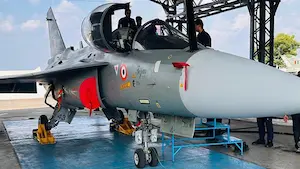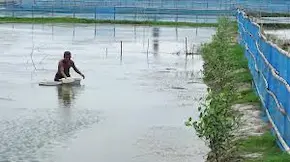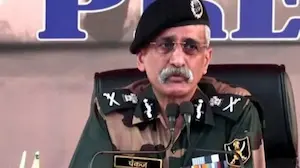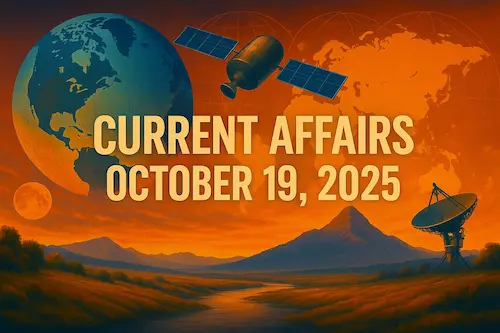1.Tejas LCA Mk1A: Boost to Indigenous Defence Manufacturing – Defence & Security

Why in News?
The Defence Minister recently inaugurated the third production line of the Tejas Light Combat Aircraft (LCA) Mk1A at Hindustan Aeronautics Limited (HAL), Nashik.
This marks a major step toward strengthening India’s self-reliance in defence manufacturing under the ‘Aatmanirbhar Bharat’ initiative.
Key Facts & Developments
Type: Single-engine, 4.5-generation, supersonic, multirole fighter aircraft
Developed by: Aeronautical Development Agency (ADA) under DRDO, in collaboration with HAL
Objective: Designed to replace ageing MiG-21 and Su-7 fleets of the Indian Air Force (IAF)
Operational Status and Production
Production Induction: To begin in 2024 after full-scale flight trials and certification
Manufacturing Locations: HAL facilities in Bengaluru and Nashik
Goal: Meet IAF’s demand through multiple assembly lines, ensuring higher production efficiency
Key Features of Tejas LCA Mk1A
| Category | Specifications |
|---|---|
| Design | Tailless compound delta wing for superior agility |
| Engine | General Electric F404-GE-IN20 turbofan; top speed: Mach 1.8 |
| Radar | Equipped with AESA radar (Active Electronically Scanned Array) |
| Flight System | Digital Fly-by-Wire for superior control |
| Cockpit | Modern glass cockpit, Helmet Mounted Display (HMD), HOTAS controls |
| Weapons | Capable of deploying air-to-air & air-to-ground PGMs, including BVR missiles |
| Payload Capacity | Over 4,000 kg, across 8 external hardpoints |
| Range | Combat radius: ~500 km, Ferry range: up to 1,700 km |
| Support Systems | Electronic Warfare Suite, Onboard Oxygen Generation System (OBOGS) |
| Networking | Integrated secure datalink for real-time battlefield communication |
| Maintenance | Modular design ensures high serviceability and quick turnaround |
Strategic Importance
Enhances India’s indigenous defence production capacity under Make in India
Reduces reliance on foreign military imports
Strengthens India’s air combat capabilities in the face of evolving regional threats
Positions India as a potential exporter of light combat aircraft to friendly nations
Exam Connect – Possible Questions
Prelims
1.Which of the following features is associated with the Tejas LCA Mk1A?
A. Twin-engine stealth design
B. Mach 3 speed and intercontinental range
C. AESA radar and fly-by-wire system
D. Manufactured by private defence companies only
Answer: C.AESA radar and fly-by-wire system
2.The Tejas LCA Mk1A is being developed to replace which of the following aircraft in the Indian Air Force?
A. Dassault Rafale
B. Sukhoi Su-30MKI
C. MiG-21 and Su-7
D. Mirage 2000
Answer: C. MiG-21 and Su-7
Mains
1.“The Tejas LCA Mk1A represents a significant leap in India’s indigenous military aviation capabilities.” Discuss the features and strategic implications of this platform in light of regional security dynamics.
2.Evaluate the role of indigenous platforms like the Tejas LCA in strengthening India’s defence preparedness and reducing dependency on foreign military imports.
2. FAO Honours Sundarbans’ SAIME Model for Sustainable Aquaculture – Environment

Why in News?
The Sustainable Aquaculture in Mangrove Ecosystems (SAIME) model in the Sundarbans has been granted Global Technical Recognition by the Food and Agriculture Organization (FAO). This award was conferred during the FAO’s 80th Anniversary celebrations and the World Food Forum, highlighting India’s innovative, community-led approach to sustainable aquaculture and climate resilience.
Key Facts & Developments
Sundarbans is the world’s largest mangrove delta, straddling India and Bangladesh.
🇮🇳 In India, it spans about 9,630 sq. km, mainly in West Bengal, supporting millions of livelihoods via fishing, aquaculture, and agriculture.
The SAIME model, developed by the Nature Environment and Wildlife Society (NEWS), has been internationally recognized for:
Combining shrimp farming with mangrove conservation
Promoting climate-resilient and low-carbon aquaculture
About the SAIME Model
| Aspect | Description |
|---|---|
| Model Name | Sustainable Aquaculture in Mangrove Ecosystems (SAIME) |
| Implemented By | Nature Environment and Wildlife Society (NEWS), Kolkata |
| Ecological Focus | Maintains 5%–30% mangrove coverage within aquaculture ponds |
| Aquaculture Type | Mainly shrimp farming in harmony with mangrove ecosystems |
| Economic Impact | Farmers reported 100%+ increase in net profits post implementation |
| Environmental Benefit | Enhances biodiversity, supports carbon sequestration, and improves coastal resilience |
| Climate Significance | Promotes nature-based solutions to sea-level rise and habitat degradation |
Environmental and Social Importance
Biodiversity Protection: Restores mangrove habitat critical for fish breeding, bird nesting, and wildlife corridors.
Livelihood Resilience: Strengthens incomes of coastal and tribal communities vulnerable to climate shocks.
Low-Carbon Development: Model aligns with goals of a blue economy and climate-adaptive agriculture.
Policy Relevance: Serves as a scalable model for other Indian coastal states like Odisha, Andhra Pradesh, and Gujarat.
FAO’s Recognition
The SAIME model was honoured as part of the FAO’s global initiative to promote sustainable food systems.
This marks international validation of India’s community-based approaches to integrating conservation with development.
Exam Connect – Possible Questions
Prelims
1.The SAIME model, recently awarded by the FAO, primarily integrates which two aspects?
A. Irrigation efficiency and GM crops
B. Shrimp farming and hydroelectric power
C. Aquaculture and mangrove conservation
D. Solar energy and urban agriculture
Answer: C. Aquaculture and mangrove conservation
2.Which of the following organizations developed the SAIME model in the Indian Sundarbans?
A. Central Marine Fisheries Research Institute (CMFRI)
B. Nature Environment and Wildlife Society (NEWS)
C. National Biodiversity Authority
D. Wildlife Institute of India
Answer: B.Nature Environment and Wildlife Society (NEWS)
Mains
1.“Nature-based solutions like the SAIME model offer an integrated path for biodiversity conservation and economic development.” Critically examine this statement in the context of India’s coastal ecosystem management.
2.Discuss the potential of integrating sustainable aquaculture with ecosystem restoration in India’s coastal regions. How can models like SAIME contribute to a resilient blue economy?
3. India–US Trade Deal: Balancing Strategic Gains and Economic Sovereignty – International Relations

Why in News?
As part of the ASEAN Summit in Kuala Lumpur (October 26–28), a potential India–US trade agreement is expected to be finalized during high-level talks between the Indian Prime Minister and the US President.
This evolving deal presents both economic opportunities and strategic risks, especially in sectors like digital trade, agriculture, and data sovereignty.
Key Facts & Developments
India’s Goals:
Protect domestic sectors like agriculture, fisheries, and digital economy
Expand export markets, especially in pharmaceuticals, textiles, and IT services
US Objectives:
Greater access to Indian markets, especially in:
Agricultural exports
Digital services and e-commerce
Oppose Indian policies on digital taxation and data localization
Strategic and Economic Concerns for India
1. Documenting Commitments Before Announcements
India must formalize all terms in writing before public declarations to prevent post-agreement shifts by the US—an issue observed in past negotiations.
2. Avoiding Last-Minute US Demands
The US has a record of introducing last-minute conditions.
India must avoid being pressured into unfavorable clauses during final negotiations.
3. Reducing Overdependence on US Markets
Overreliance could lead to strategic vulnerabilities, especially if geopolitical tensions escalate.
India should continue to diversify exports across regions (EU, ASEAN, Africa, Latin America).
4. Protecting Core Sectors
Agriculture & fisheries: Domestic subsidies, import restrictions, and smallholder livelihoods must be safeguarded.
Digital economy:
India’s interests lie in taxing foreign tech giants, regulating cross-border data flow, and preserving data sovereignty.
US resistance could compromise India’s digital autonomy.
5. Strategic Autonomy and Reciprocity
India must uphold strategic autonomy and insist on mutual benefit.
Any deal should align with the Atmanirbhar Bharat (self-reliant India) vision.
Opportunities for India
Greater global trade integration with a key partner
Boost to manufacturing exports and services sector
Enhanced cooperation in tech, defense, and clean energy sectors
Way Forward
| Objective | Strategy |
|---|---|
| Maintain Sovereignty | Protect sensitive sectors and avoid blanket liberalization |
| Insist on Reciprocity | Ensure mutual concessions, not one-sided benefits |
| Diversify Trade | Expand trade partnerships beyond the US |
| Be Ready to Exit | Walk away from the deal if it compromises long-term interests |
Exam Connect – Possible Questions
Prelims
1.Which of the following sectors is India particularly cautious about while negotiating the India–US trade deal?
A. Renewable energy
B. Education and tourism
C. Agriculture and digital economy
D. Real estate and construction
Answer: C. Agriculture and digital economy
2.Which of the following best describes India’s principle of “strategic autonomy” in trade negotiations?
A. Aligning only with Western economies
B.Avoiding all foreign collaborations
C. Engaging globally while safeguarding national interests and policy flexibility
D. Dependence on multilateral agencies like the IMF and WTO
Answer: C. Engaging globally while safeguarding national interests and policy flexibility
Mains
1.“The India–US trade deal must strike a balance between economic opportunity and strategic sovereignty.” Discuss the major concerns India faces in finalizing such bilateral agreements.
2.Critically examine how India’s evolving trade relationship with the US reflects its broader foreign policy objectives in the context of Atmanirbhar Bharat.
4. Gorkhaland Statehood Demand: Government Appoints Interlocutor for Talks – Polity

Why in News?
In a significant political move, the Government of India has appointed Pankaj Kumar Singh, former Deputy National Security Advisor (DY NSA), as the interlocutor for Gorkha talks.
This appointment revives official dialogue on the long-standing Gorkhaland statehood demand, signaling renewed focus on issues of identity, representation, and regional autonomy within India’s federal framework.
Key Facts & Developments
Revival of Talks: First formal negotiations after years of political stalemate.
High-Level Appointment: Appointment of a former DY NSA shows the security and political sensitivity of the issue.
Core of the Issue: The demand revolves around ethnic identity, governance, and constitutional recognition of the Gorkha community.
Political Timing: Strategically significant ahead of West Bengal Assembly Elections to address concerns of hill voters.
Broader Implication: May set a precedent for negotiated resolution of other regional or sub-nationalist movements.
Historical Context
| Timeline | Key Events |
|---|---|
| 1907 | First demand for a separate administrative unit for Nepali-speaking people in Darjeeling |
| 1980s | Violent agitation led by Gorkha National Liberation Front (GNLF); over 1,200 people killed |
| 2000s–2010s | Renewed demands by Gorkha Janmukti Morcha (GJM); Gorkhaland Territorial Administration (GTA) formed as a compromise |
| Present | Continued demand for full statehood, and better constitutional safeguards |
Key Demands of the Gorkha Movement
Creation of Gorkhaland as a separate state within India, carved out of northern West Bengal (mainly Darjeeling, Kalimpong, and Dooars region)
Scheduled Tribe status for 11 sub-tribes of the Gorkha community
Constitutional recognition to protect the political and cultural identity of Gorkhas
Better educational, employment, and political representation for hill communities
Comparative Context: Statehood Demands in India
Since independence, over 30 significant statehood demands have emerged
Motivated by:
Cultural identity (e.g., Bodoland, Vidarbha)
Developmental neglect (e.g., Purvanchal, Bundelkhand)
Administrative convenience (e.g., Coorg, Tulu Nadu)
Way Forward
| Priority | Action |
|---|---|
| Dialogue-Centric Approach | Institutionalize talks through an empowered interlocutor |
| Constitutional Safeguards | Explore legal recognition and protection mechanisms |
| Inclusive Development | Focus on economic, social, and educational upliftment of the hill population |
| Avoid Violence & Coercion | Resolve demands through democratic, peaceful means |
Exam Connect – Possible Questions
Prelims
1.Which Article of the Indian Constitution empowers Parliament to create new states or alter existing ones?
A. Article 352
B. Article 370
C. Article 3
D. Article 280
Answer: C.Article 3
2.The Gorkhaland movement primarily demands statehood for which region?
A. Sikkim
B. Darjeeling and adjoining areas of northern West Bengal
C. Jammu
D. Meghalaya
Answer: B. Darjeeling and adjoining areas of northern West Bengal
Mains
1.Discuss the constitutional and political dimensions of regional statehood demands in India, with special reference to the Gorkhaland movement.
2.Evaluate the role of interlocutors in resolving regional identity-based movements. Can the appointment of a high-level interlocutor help in addressing the Gorkhaland demand effectively?
5. Rising CO₂ Levels: Understanding the Current Climate Crisis – Environment
Why in News?
The World Meteorological Organization (WMO) has reported that the global concentration of carbon dioxide (CO₂) reached 423.9 ppm in 2024, marking a record annual rise of 3.5 ppm—the highest ever recorded.
Additionally, 2024 has been declared the warmest year on record, with global temperatures 1.55°C above pre-industrial levels, crossing the 1.5°C threshold over an entire year for the first time.
Key Facts & Developments
CO₂ Levels: Reached 423.9 ppm in 2024 – highest recorded in human history
Temperature Rise: Global average temperature rose 1.55°C above pre-industrial levels
Threshold Breach: Crossed the Paris Agreement’s 1.5°C limit – a critical benchmark for climate action
Other GHGs: Increases also recorded in methane (CH₄) and nitrous oxide (N₂O), though at a slower pace
Understanding the Sources of CO₂ Emissions
Natural Sources:
Respiration by living organisms
Forest fires and wildfires
Volcanic eruptions
Decomposition of organic matter
Anthropogenic (Human-Made) Sources:
Burning of fossil fuels (coal, oil, natural gas)
Industrial processes (cement, steel)
Deforestation and land-use change
Transportation and energy generation
Carbon Imbalance:
Natural systems usually absorb as much CO₂ as they emit
However, only about 50% of human-induced emissions are absorbed by land and oceans
Remaining CO₂ accumulates in the atmosphere, driving global warming
CO₂ in Context: The Role of Greenhouse Gases
| Gas | Heat-Trapping Capacity (Compared to CO₂) | Atmospheric Lifetime | Contribution to Warming |
|---|---|---|---|
| CO₂ | Baseline (1x) | Hundreds to thousands of years | ~66% of total warming |
| CH₄ (Methane) | ~25x more potent | ~12 years | Increasing trend |
| N₂O (Nitrous Oxide) | ~270x more potent | ~114 years | Long-term risk |
Despite being less potent molecule-for-molecule, CO₂ remains the most dangerous because of:
Its abundance
Its long atmospheric lifespan
Its massive contribution to the greenhouse effect
Worsening Climate Trends (2023–2024)
Increased forest fires released significant CO₂
Warmer oceans absorbed less carbon
Land-based carbon sinks under stress due to heat and drought
Failure to meet Paris Agreement targets for emission reduction by 2030
Implications for India and the World
Extreme weather events (floods, droughts, heatwaves) likely to intensify
Impact on agriculture, water security, and health
Highlights urgent need to:
Transition to renewable energy
Strengthen carbon sink restoration
Implement climate adaptation strategies
Global Climate Governance and Policy Failures
The Paris Agreement aims to limit warming to well below 2°C, preferably 1.5°C
Current trends suggest global emissions are not on track to meet 2030 targets
Climate commitments remain voluntary and non-binding, reducing enforcement power
Exam Connect – Possible Questions
Prelims
1.Which of the following greenhouse gases is the most abundant contributor to long-term global warming?
A. Methane
B. Nitrous oxide
C. Carbon dioxide
D. Ozone
Answer: C. Carbon dioxide
2.The 1.5°C temperature threshold mentioned in the Paris Agreement refers to:
A. Seasonal variation in the Arctic region
B. Limit on nighttime temperatures in tropical countries
C. Maximum global average temperature rise above pre-industrial levels
D. Annual rainfall increase cap in Asia
Answer: C. Maximum global average temperature rise above pre-industrial levels
Mains
1.“Carbon dioxide is less potent than methane or nitrous oxide but remains the greatest threat to climate stability.” Discuss the causes, consequences, and control strategies for rising atmospheric CO₂.
2.Despite the Paris Agreement, CO₂ emissions continue to rise. Critically analyze the gaps in international climate governance and suggest ways to strengthen global cooperation.

